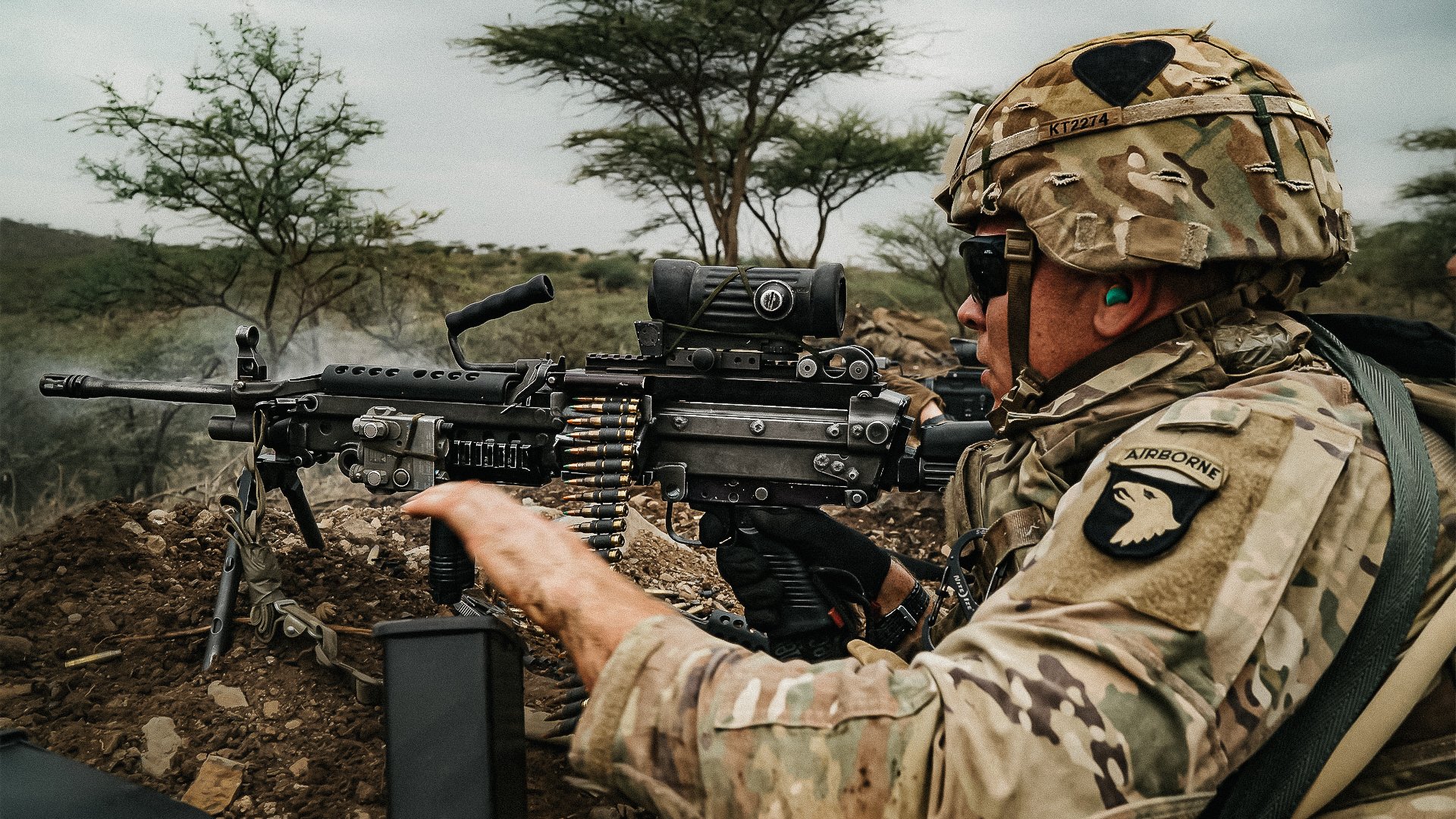
US Army Pfc. Kevin Todd, an automatic rifleman assigned to Alpha Company, 1-26 Infantry, 101st Airborne Division provides support-by-fire for an assault team during a live fire training scenario at the Hurso Training Field, Ethiopia, for Justified Accord on June 26, 2019. US Air Force photo by Airman First Class Brennen Lege.
On the afternoon of May 10, 1970, US Army Spc. Leslie Sabo Jr. and a company of paratroopers from the 3rd Battalion, 506th Infantry Regiment, 4th Brigade Combat Team, 101st Airborne Division were on a routine reconnaissance patrol in Cambodia when they were caught in a U-shaped ambush.
Enemy fire raked the American formation, inflicting heavy casualties. Sabo immediately assaulted the nearest enemy position, killing several North Vietnamese Army soldiers. With complete disregard for his own safety, Sabo attacked another group of enemy soldiers attempting to flank the patrol. He killed them, too, expending all of his ammunition in the process.
Sabo returned to the ambush site to retrieve ammunition from his dead platoon mates. He found one of his fellow soldiers wounded but alive and began rendering aid. When an enemy grenade landed nearby, Sabo grabbed the deadly device and threw it back. He covered his wounded comrade with his body just as the grenade exploded. It riddled Sabo’s body with shrapnel.
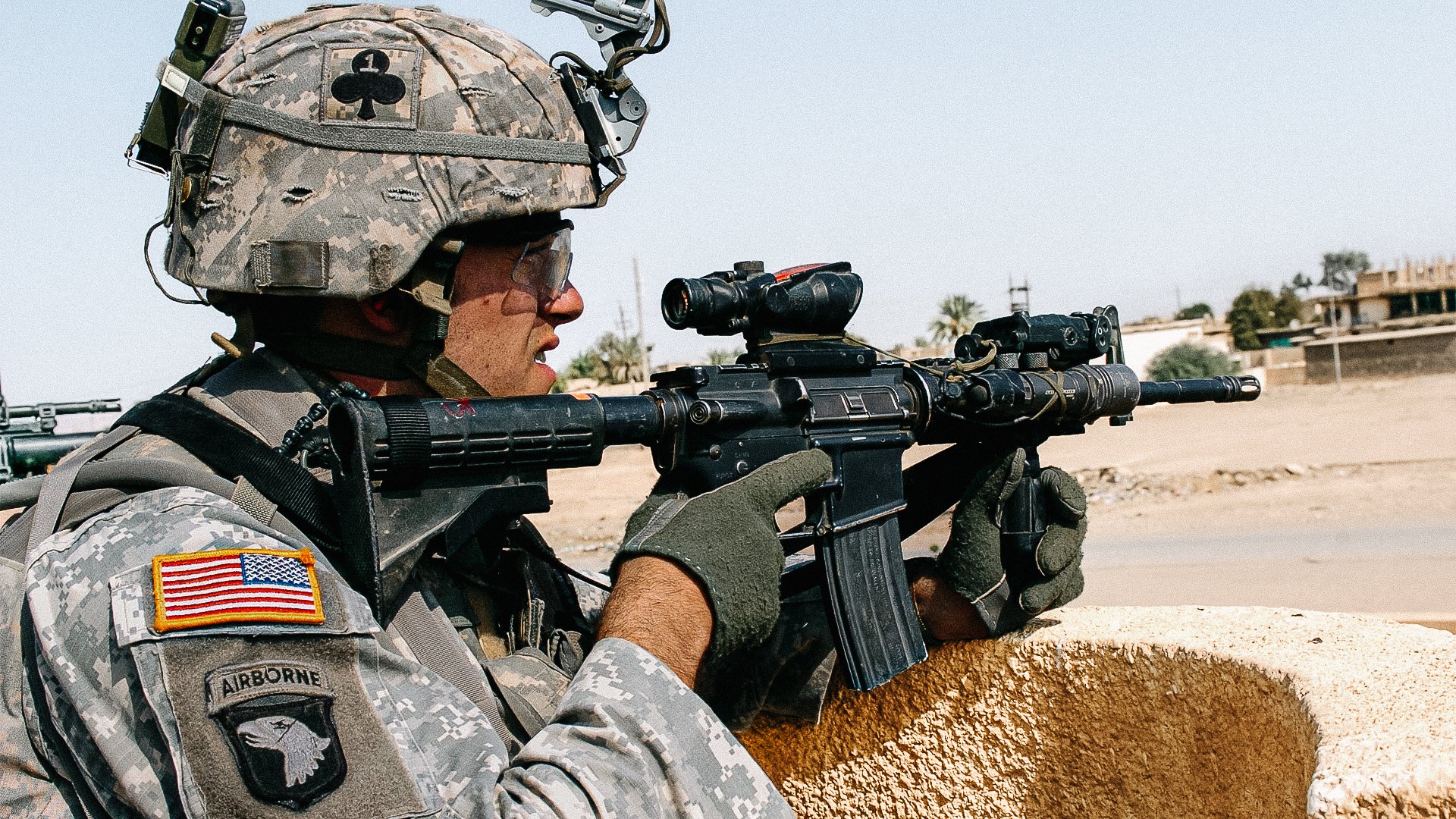
Soldiers from 1/327th Infantry Regiment, 1st Brigade Combat Team, 101st Airborne Division along with Iraqi policemen come under fire from insurgents in the restive city of Suniyah in the Salah Ad-Din province, Iraq, Oct. 26, 2007. US Army photo by Rick Rzepka.
Sabo — now bleeding profusely — attacked a nearby bunker by himself. He was mortally wounded by machine gun fire, but he managed to crawl within yards of the bunker and throw a grenade inside. The blast destroyed the enemy position but also killed Sabo.
Forty-two years after his death, Sabo became the 20th member of the esteemed 101st Airborne Division to receive the Medal of Honor. As Sabo’s final act in life revealed, the men and women of the 101st Airborne are a special breed of American soldier.
Related: 101st Airborne Paratrooper Named Army Soldier of the Year, Medic Wins NCO Award
What Is the 101st Airborne?
The 101st Airborne is an elite division of light infantry in the United States Army that specializes in air assault operations.
With three brigade combat teams, the 101st Airborne is capable of simultaneously deploying multiple units to austere environments behind enemy lines. The division has its own artillery, aviation, and sustainment brigades, which aid in the unit’s ability to deploy autonomously. The 101st’s unique mobility and self-sufficiency make it one of America’s most trusted combat-ready forces.
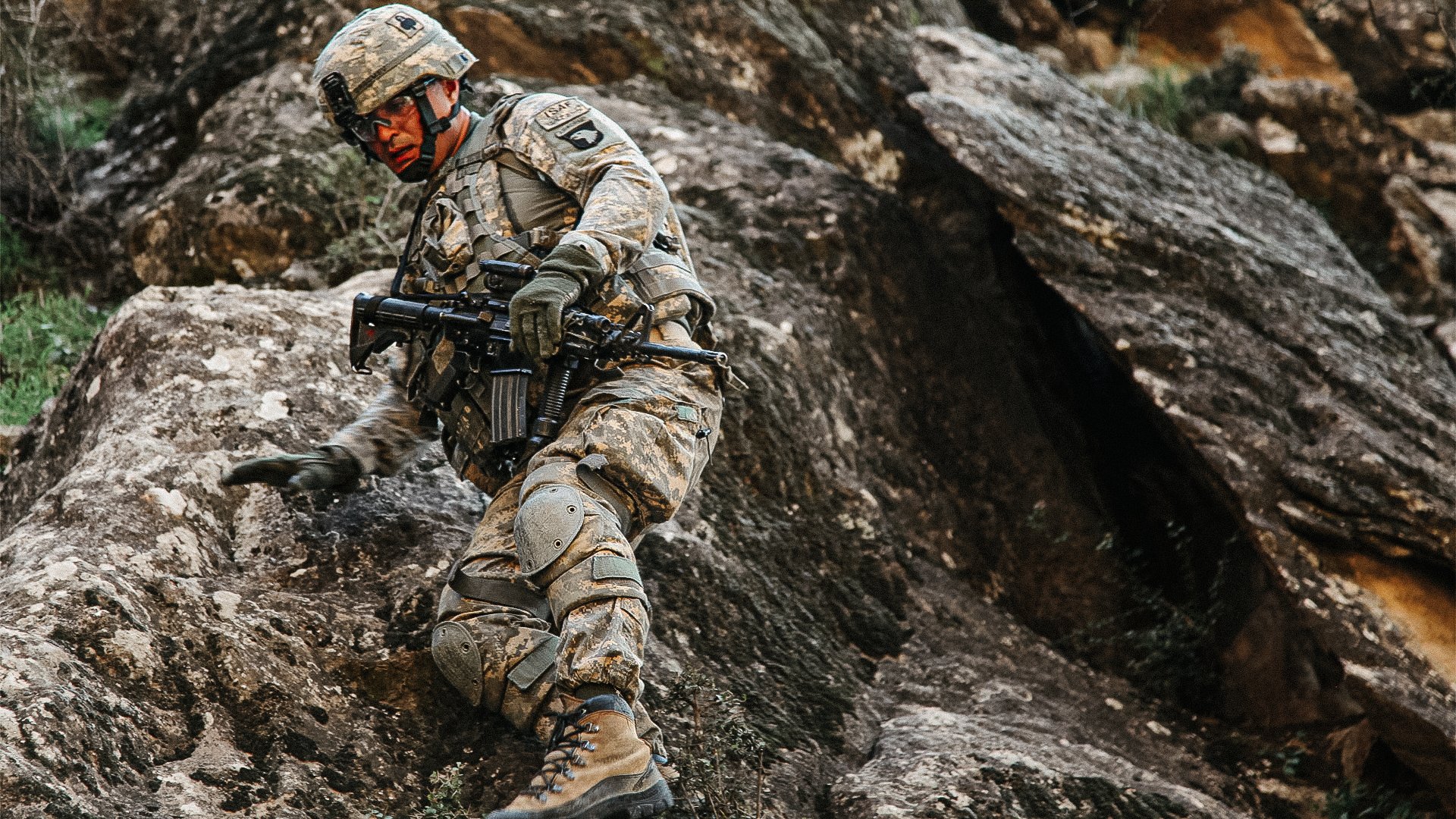
Spc. Vergil Droumev from Chicago climbs down a mountain face to reach a weapons cache in the Degwagal Valley, Konar province, Afghanistan, Oct. 4, 2010. US Army photo by Pfc. Boyd Cameron.
The 101st Airborne division’s air assault capabilities make it unlike the Army’s other airborne divisions. The 101st is colocated alongside the Army’s notoriously rigorous Sabalauski Air Assault School at Fort Campbell, Kentucky, where soldiers become experts in helicopter operations. Their training includes sling-load procedures, pathfinder operations, and fast-rope techniques. Roughly half of the soldiers who attend Air Assault School fail to complete the difficult training. Those who graduate the grueling course are permitted to wear the Air Assault Badge.
Soldiers of the 101st Airborne wear black berets bearing the insignia of the subordinate unit they belong to. Members of the 1st Brigade Combat Team, 2nd Brigade Combat Team, and 3rd Brigade Combat Team each have distinctive unit insignias. The 101st Combat Aviation Brigade also has its own unique insignia. However, every soldier in the 101st wears a shoulder patch bearing the division’s insignia of a bald eagle on a black shield.
Related: The Most Decorated Officer in the History of the 82nd Airborne Laid to Rest in Arlington
Why Is the 101st Airborne Famous?
While the Screaming Eagle is recognizable around the world, the 101st isn’t known simply for the iconic design. First formed in 1918 as a regular infantry unit, the division was redesignated an airborne unit in 1942 at Camp Claiborne, Louisiana. The division’s first commander, Maj. Gen. William C. Lee, famously told his men, “The 101st has no history, but it has a rendezvous with destiny.”
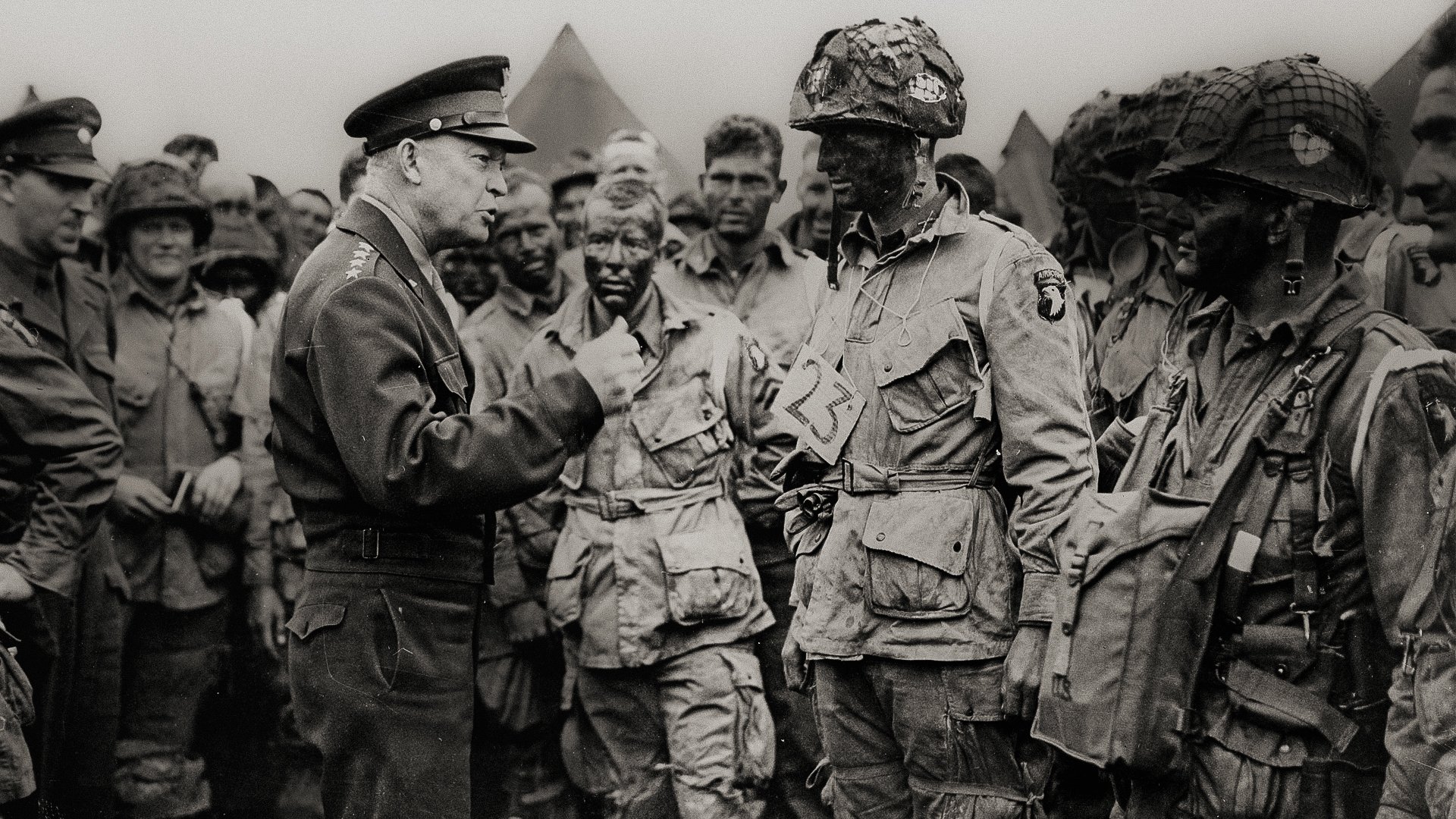
Gen. Dwight D. Eisenhower meeting with Easy Company, 502nd Parachute Infantry Regiment (Strike) of the 101st Airborne Division, June 5, 1944. Photo courtesy of Wikimedia Commons.
That destiny awaited them on the European battlefields of World War II, where the newly christened paratroopers would forge their reputation as a formidable airborne fighting force.
The 101st conducted two combat jumps during the war. On June 6, 1944, the Screaming Eagles jumped into Normandy, preceding the amphibious landings on D-Day. They seized four causeways leading from Utah Beach, trapping the coast’s German defenders.
They then established two bridges across the Dove River to seize the strategically important city of Carentan. Three months after landing in Normandy, the 101st conducted its second combat jump of the war.
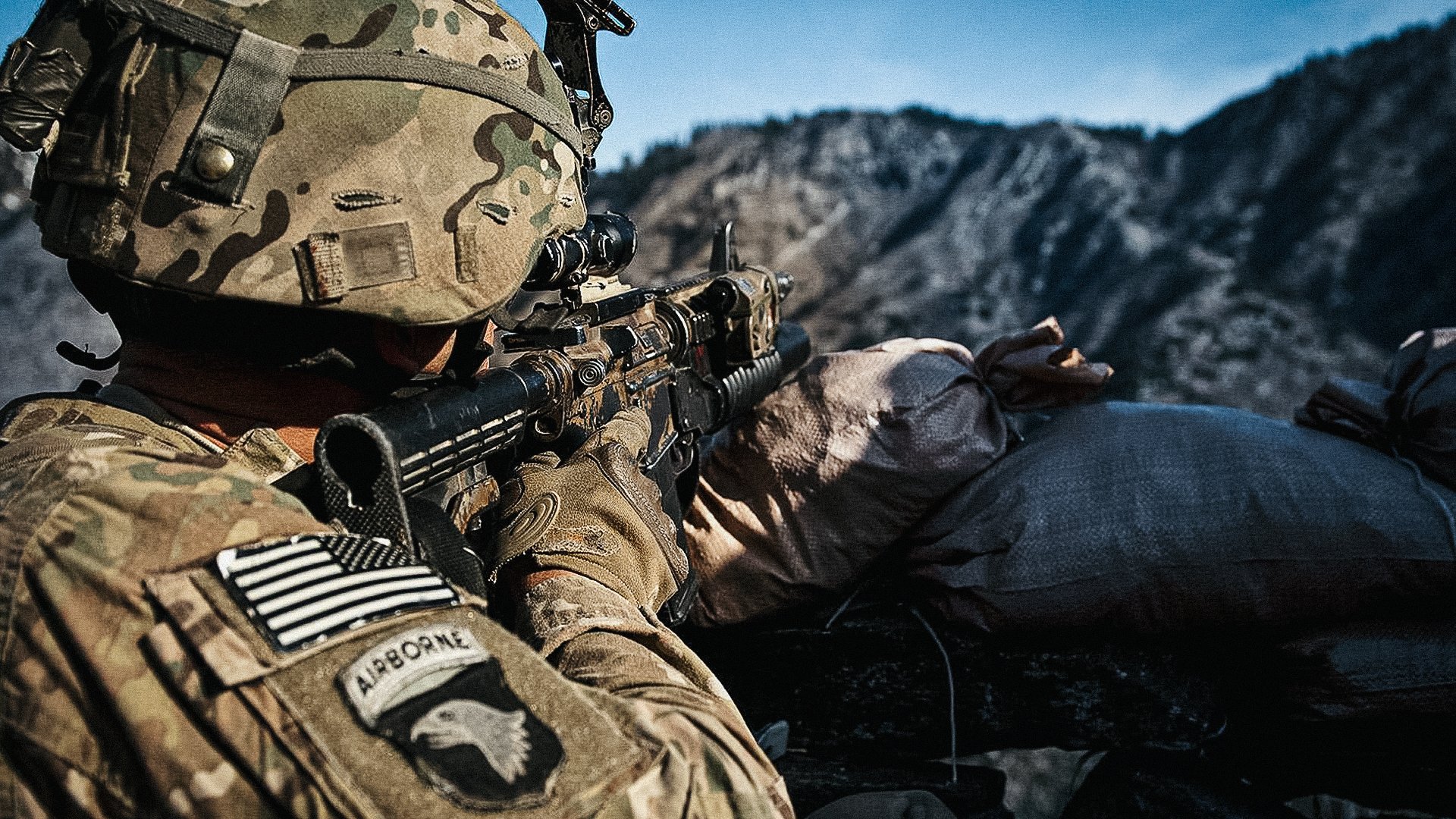
Sgt. Nathaniel S. Gray, an infantry squad leader from Tupelo, Mississippi, assigned to Company B, 2nd Battalion, 327th Infantry Regiment, 1st Brigade Combat Team, 101st Airborne Division, uses his combat optics to search for insurgent fighters during a recent combat operation in Shigal District of eastern Afghanistan's Kunar province, March 16, 2011. US Army photo by Sgt.1st Class Mark Burrell.
On Sept. 17, 1944, the division jumped into the Netherlands in what remains the largest airborne operation in history. While the operation failed to end the war, the 101st met their objectives and liberated the Dutch cities of Eindhoven and Nijmegen.
Following their fight across the Netherlands, paratroopers of the 101st played a key role in the Battle of the Bulge. During the last major German offensive of the war, soldiers of the 101st became encircled near the city of Bastogne, where, despite dwindling ammunition and freezing temperatures, they held off the enemy’s advances. The 101st Airborne’s stalwart defense earned them the nickname “The Battered Bastards of Bastogne.”
Related: 5 Things You Probably Didn’t Know: ‘Band of Brothers’
The Screaming Eagles After World War II
The 101st Airborne continued to make history after World War II. Members of the division were called on to escort African American students into school during the Civil Rights movement. During the Vietnam War, the division distinguished itself in major engagements such as the battles for Hamburger Hill and Firebase Ripcord. Of the 20 Medals of Honor awarded to members of the 101st Airborne, 18 were given for actions during the Vietnam War.

Soldiers from the 2/327th No Slack Battalion, 101st Airborne Division, return fire after receiving small-arms fire during combat operations in the valley of Barawala Kalet, Kunar province, Afghanistan, March 29, 2011. US Army photo by Pfc. Cameron Boyd.
In 1974, the 101st Airborne officially transitioned into an air assault division. Vietnam exposed the value of soldiers who were experts in helicopter operations rather than static-line parachute operations.
The division made history again in 2001, when members of the 101st became the first conventional soldiers in the US Army to deploy to Afghanistan as part of Operation Enduring Freedom. The division continued to fight in Afghanistan for the next 20 years, while also deploying forces to the war in Iraq.

Soldiers from the 1st Battalion, 187th Infantry Regiment, 101st Airborne Division (Air Assault), scan the ridgeline for enemy forces during Operation Anaconda, March 4, 2002. US Army photo by Spc. David Marck Jr.
On April 2, 2017, 40 soldiers of the 101st Airborne Division deployed to Somalia during the country’s civil war as trainers and advisers — a role that typically falls to special operations forces.
Related: What Really Happened at Vietnam’s Hamburger Hill?
The 101st Airborne Today
The 101st Airborne Division’s air assault soldiers remain ready to deploy anywhere in the world at a moment’s notice. Last year, 4,700 soldiers from the division deployed across Europe to bolster NATO forces in the face of Russian aggression. While no soldiers are deployed to Ukraine, their presence across Europe sends a clear message: The 101st Airborne is poised and ready to defend America’s allies.
Read Next: Death From Above: Everything to Know About the 82nd Airborne Division
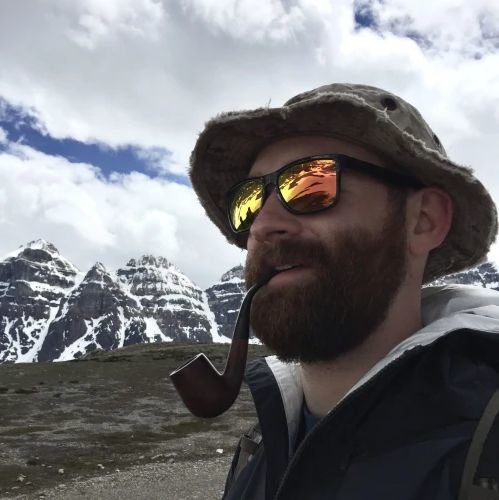
Mac Caltrider is a senior staff writer for Coffee or Die Magazine. He served in the US Marine Corps and is a former police officer. Caltrider earned his bachelor’s degree in history and now reads anything he can get his hands on. He is also the creator of Pipes & Pages, a site intended to increase readership among enlisted troops. Caltrider spends most of his time reading, writing, and waging a one-man war against premature hair loss.
BRCC and Bad Moon Print Press team up for an exclusive, limited-edition T-shirt design!
BRCC partners with Team Room Design for an exclusive T-shirt release!
Thirty Seconds Out has partnered with BRCC for an exclusive shirt design invoking the God of Winter.
Lucas O'Hara of Grizzly Forge has teamed up with BRCC for a badass, exclusive Shirt Club T-shirt design featuring his most popular knife and tiomahawk.
Coffee or Die sits down with one of the graphic designers behind Black Rifle Coffee's signature look and vibe.
Biden will award the Medal of Honor to a Vietnam War Army helicopter pilot who risked his life to save a reconnaissance team from almost certain death.
Ever wonder how much Jack Mandaville would f*ck sh*t up if he went back in time? The American Revolution didn't even see him coming.
A nearly 200-year-old West Point time capsule that at first appeared to yield little more than dust contains hidden treasure, the US Military Academy said.












